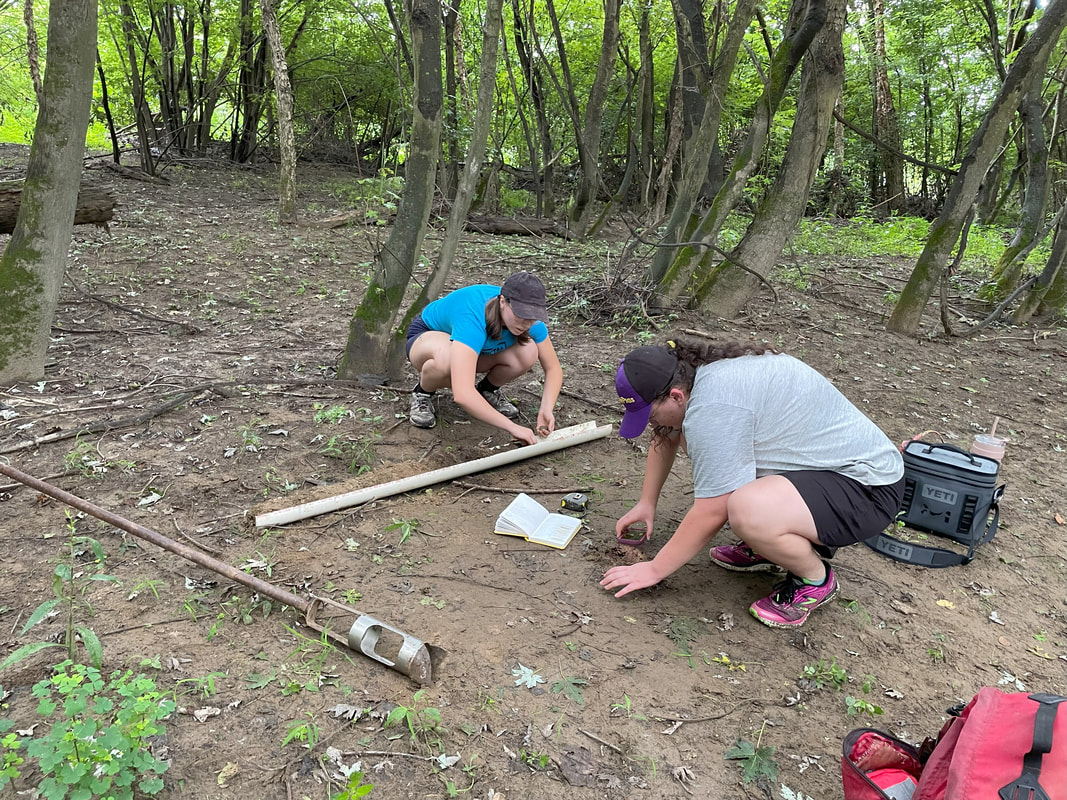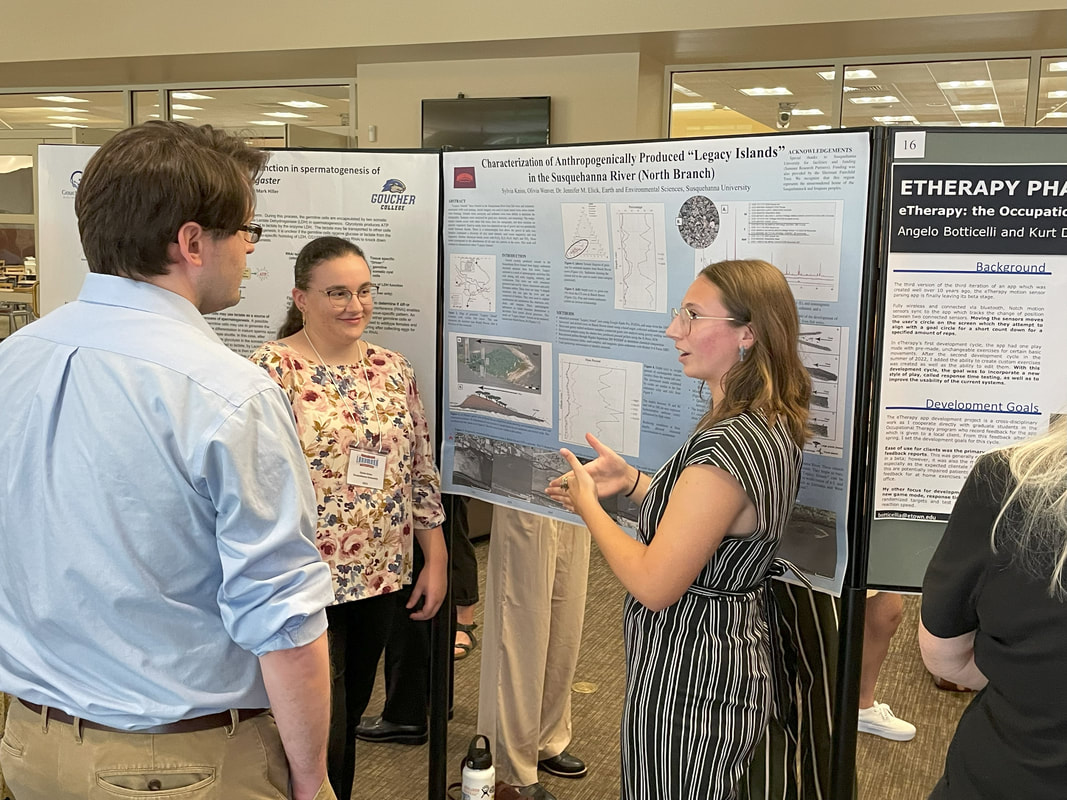|
Deep within core samples taken this summer from an unnamed Susquehanna River island near Beach Haven (just north of Berwick in Luzerne County), Dr. Jennifer Elick and two of her Susquehanna University students discovered an unexpected cocktail of components. In addition to some minerals likely delivered by glaciers, they found anthracite coal, hematite, shale chips, coke, magnetic glass and iron oxyhydroxide – elements found regularly in coal waste. “The magnetic glass is the kind of thing that forms inside of furnaces associated with burning coal. Iron oxyhydroxide are the little chips that form as a precipitate from acid mine drainage – that material is ripped up during floods and transported downstream,” said Elick. “All of that along with magnetite and metal from industrial waste – it was all mixed into this sand and gave us a new perspective as to the sources of the sediment and composition of the island itself.”
“Tunkhannock is my hometown and the fish weir there actually was covered with giant gravel dunes – so big, in fact, that their crests were spaced anywhere between 15 to 18 meters apart,” she said. “When I started looking at other giant ripples, often they formed a V-shape. It struck me that this gravel, as it was working its way downstream during major floods, was being caught by some of the fish weirs that are in the North Branch of the Susquehanna River. The gravel appeared to form the base of the legacy islands we were examining.”
She and environmental science students Olivia Weaver (of Sunbury) and Sylvia Kniss (Kempton) spent the summer collecting core samples, using a hand auger that allowed them to examine sediment nearly 2.7 meters deep. From each core, they collected about 50 grams of soil from 10-centimeter lengths. “Those we did a couple of tests on, including a grain-size analysis to determine amounts of sand, silt and clay in each sample,” said Weaver. “We ran them through an XRD and XRF machine to determine chemistry and mineralogy. We also took a tiny auger and drilled cores into the trees so we could determine the age and species to help test theories we had on how old these islands were and what stage of development they were in.” In addition, they studied the terrain, took notes and used a gravelometer to measure the size of gravel on the island’s surface. They also examined the sediment with a petrographic microscope. The islands in this area of the river have historically been classified as stratified drift – basically sediments that glaciers picked up and escorted downstream. When the glaciers melted, the streams coming from that ice would deposit sediment along the floodplains. “The expectation was that we’d find drift, but I also knew from previous studies along the main stem of the Susquehanna that I have done with students that there is a lot of coal waste,” said Elick, who added that she had seen a 1983 master thesis that identified legacy islands forming from coal waste in the lower Susquehanna River basin. “I had that in the back of my mind, and when we started drilling into this island, I started to notice the amount of material associated with coal mining and burning.” While there were minerals associated with the glacial impacts that are otherwise not present in the region’s bedrock – such as garnet, tourmaline, hornblende and augite – the density of coal-related waste was hard to ignore. “It is a guessing game as to where the coal waste originated, but if you’ve ever cleaned up a stream in this area, you know that people have a tendency of taking their garbage and waste and throwing it out of site, and out of mind, and sometimes that is into streams directly,” said Elick. “A lot of these materials have been in stream systems for a very long time. It wasn’t deposited yesterday. It has been working its way down the river basin incrementally for decades.” Age and scope The composition of coal waste in the island’s foundation, according to Weaver, indicates it is younger than the start of region’s coal industry boom, and ages pulled from tree samples in relation to major flood events also helps fill in the bigger picture. Plastic was found mixed with the coal sediment. “The oldest trees can be dated back to a high-energy event that is putting a lot of sediment and seeds into the fish weir structure,” she said. “While the traces of this island can first be seen on aerial photographs dating back to the late 1930s, the expansion of that island is connected directly to the 1972 flood. The occurrence of plastic in the sediment allows us to estimate recent deposition of sediment.” Elick added that the Agnes flooding removed much of what was on the island at that time. “When you have a massive flooding event, you have a lot of moving gravel. What we found when we drilled down through the island in different places is that this layer of gravel extended almost entirely across the island,” she said. “From that gravel, the trees of this island have their roots. The oldest tree we found is about 46 years old.” While the study has focused on the island near Tunkhannock, the team has noticed a number of other islands with similar characteristics that likely tie back to legacy coal waste. “We have noticed a site near Dalmatia where there are some weirs in line with a possible legacy island, and another location near Harrisburg,” said Weaver. “There are quite a few possibilities that have yet to be researched.” While they have focused mainly on the North Branch and main stem, the same phenomenon likely is occurring in the West Branch, Elick added. “There are potentially some islands forming now or may form in the future as coal waste from the mining industry in that direction for bituminous coal,” she said. “There is legacy sediment from the logging industry, but unfortunately logging sediment from mountaintops may be harder to identify vs. something like coal waste.” Legacy lessons Weaver admits she feels a closeness to this project due to where she grew up. “I chose a school close to me with an environmental program because I wanted to study the Susquehanna River,” she said. “You don’t have to travel far to explore or research or make an impact because there are so many things to investigate right in your own backyard.” She added that there is much to learn from this specific study. “There is this idea out there that what we do won’t have lasting effects on the environment, but investigating these islands has given me the perspective that even if you can’t tell right away, what we do does affect the river. It does affect the wildlife. It does affect the stream flow and definitely the sedimentation of the river,” she said. “When you walk on these islands, you can’t immediately see the coal waste, but it is there. It created these islands and that changes things.” Elick, who plans to use what she learned in this study to continue to explore and research other potential legacy islands in the Susquehanna River, re-emphasized the legacy concept of these legacy islands. “Realize that some of this sediment was deposited in the flood plain farther upstream and later was washed down and then deposited in some other location, and then washed down again – incrementally making its way down the river,” she said. “When you think of putting new industries on the river or near the river, and then you think about how we utilize resources upstream and how they impact the river and its sediment – it all eventually makes its way downstream. “This really should tell the public tat we have a legacy that is really strong and it lasts for a long period of time. Whatever industry goes upstream from us is going to have a long-term impact that takes a long time to clean out.” Learn more about Elick, Weaver and Kniss’ legacy island work in Susquehanna University’s online newsroom.
1 Comment
9/28/2023 03:13:12 pm
Great research and well written article. We plan to post on our website since a large portion of our work is Legacy Sediment related. Keep up the great work! Send linked in invites if interested. Regards, Joe Sweeney, Executive Director, WSI
Reply
Leave a Reply. |
AuthorsRiverkeeper John Zaktansky is an award-winning journalist and avid promoter of the outdoors who loves camping, kayaking, fishing and hunting with the family. Archives
July 2024
Topics |


 RSS Feed
RSS Feed